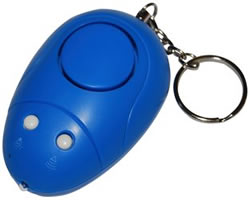Personal Safety Devices & Self-Defense for Seniors
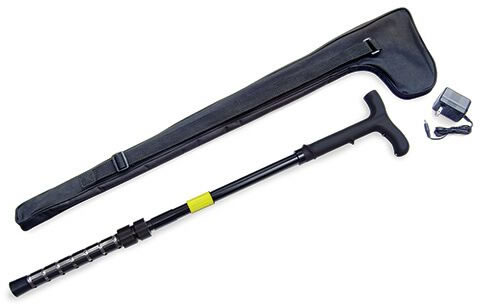
Looking for simple, effective protection tools for older adults? At TBOTECH, we specialize in senior-friendly safety gear that’s easy to use, lightweight, and reliable—no training required. Explore personal alarms, self-defense canes, and non-lethal devices that help seniors stay safe and independent.
As we age, personal safety becomes more important than ever. Whether at home, running errands, or traveling, having the right self-defense tools and safety devices can provide peace of mind and protection.
This guide covers the best personal safety devices for seniors, from non-lethal self-defense weapons to wearable security technology that enhances independence while ensuring safety.
Why Personal Safety Matters for Seniors
Unfortunately, criminals often see older individuals as easy targets due to limited mobility or slower reaction times. However, the right safety tools and self-defense strategies can help seniors feel confident, prepared, and secure in any situation.
Key benefits of using personal safety devices:
✔ Quick and easy protection – No extensive training needed.
✔ Non-lethal and legal – No risk of serious harm or legal trouble.
✔ Enhances independence – Provides security at home and in public.
✔ Deters potential threats – Prevents crime before it happens.
Top Personal Safety Devices for Seniors
1. Personal Alarms – Loud & Effective Deterrents
Personal safety alarms are one of the best non-violent protection tools for seniors. With the press of a button, these devices emit an ear-piercing 120-130 dB alarm that can startle attackers and alert others nearby.
♦ Best for: Seniors who want a simple, no-contact self-defense option.
- Easy to activate in emergencies.
- Compact and attaches to keychains or bags.
- No legal restrictions – safe to carry anywhere.
2. Pepper Sprays – Compact & Highly Effective
Pepper spray is a powerful deterrent that incapacitates attackers by causing burning pain, temporary blindness, and breathing difficulty. It provides a safe distance defense without needing physical strength.
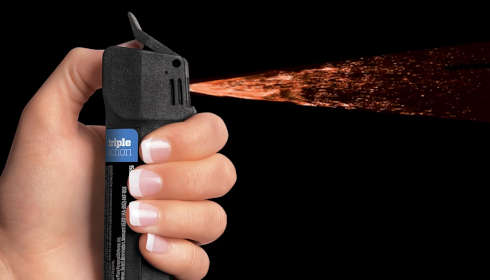
♦ Best for: Seniors comfortable with carrying a small but effective defensive tool.
- 8–12 ft range keeps attackers at a safe distance.
- Compact keychain and lipstick-style designs.
- Some include UV dye to help police identify attackers.
✦ Explore Senior-Friendly Pepper Sprays
3. Self-Defense Canes – Support & Protection in One
A sturdy walking cane isn’t just for mobility – it can be a powerful self-defense tool. Some canes are reinforced for striking power, while stun canes add an extra layer of protection with an electric charge at the tip.
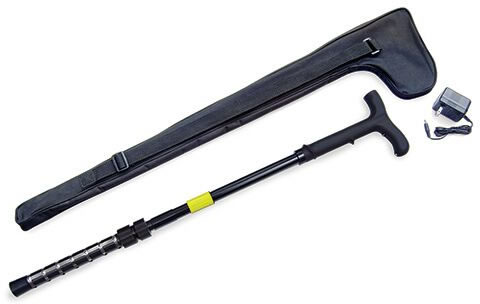
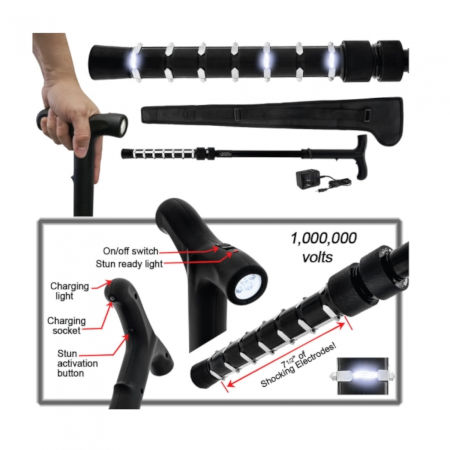
Stun Cane with Flashlight 1 Million Volts
- Strong enough to strike an attacker if needed.
- Stun canes provide a non-lethal electric shock for extra protection.
- Some models include built-in flashlights for visibility.
4. Tactical Flashlights – Light Up & Defend
A tactical flashlight isn’t just for visibility – it can also be used as a blunt-force self-defense tool or even a stun device in some models.
- Ultra-bright LED light to blind attackers.
- Durable aluminum body for striking.
- Some include a built-in stun feature.
✦ Check Out Tactical Flashlights
5. Wearable Medical & Emergency Alert Devices
For seniors who live alone or have medical concerns, emergency alert devices provide instant contact with family, caregivers, or emergency services.
- Fall detection and GPS tracking for fast response.
- Waterproof designs for continuous wear.
- Some connect directly to 911 or designated contacts.
6. TASER Devices – Maximum Protection with Distance Defense
For seniors who want a powerful, non-lethal self-defense option with distance protection, a TASER device is an excellent choice. Unlike stun guns, which require direct contact, TASER devices can immobilize a threat from up to 15 feet away.
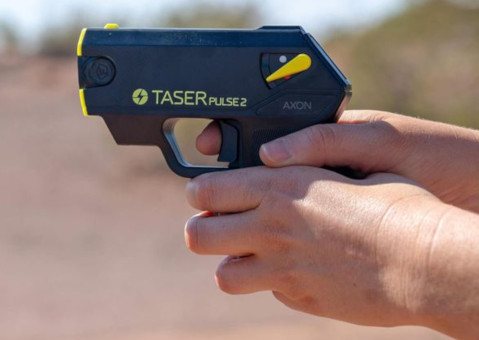
Top Pick for Seniors: The TASER Pulse 2 is lightweight, easy to carry, and designed for straightforward operation under stress — ideal for quick, confident protection.
✦ Browse TASER Devices for Self-Defense
Home Security Tips for Seniors
- Install motion-activated lights outside entryways.
- Use security cameras or video doorbells.
- Keep doors and windows locked with reinforced locks.
- Avoid opening doors to unknown visitors.
- Keep a personal alarm near entry points.
✦ Browse Home Security Solutions
Choosing the Right Personal Safety Device
- Ease of Use – Can it be activated quickly?
- Portability – Can it be carried in a purse or pocket?
- Legal Restrictions – Is it permitted everywhere?
- Comfort Level – Does the senior feel comfortable using it?
Final Thoughts – Stay Safe & Independent
No matter your age, personal safety is a priority. Whether using a personal alarm, pepper spray, or a self-defense cane, having the right tools helps seniors stay independent and confident.
Related reading: Easy-to-Carry Self-Defense Weapons for Everyday Use
Take control of your safety today! Browse our best personal safety devices for seniors and choose the one that fits your needs.
✦ Shop Personal Safety Products for Seniors
You May Also Like
- Safe Home Defense Tools – Secure your home with non-lethal protection.
- 10 Effective Self-Defense Tools – Reliable options for any lifestyle.
- Understanding Non-Lethal Weapons – Explore the best options for defense.
Stay safe, stay confident. See all self-defense tools available at TBOTECH.
Add your comment now!
Post Comment
